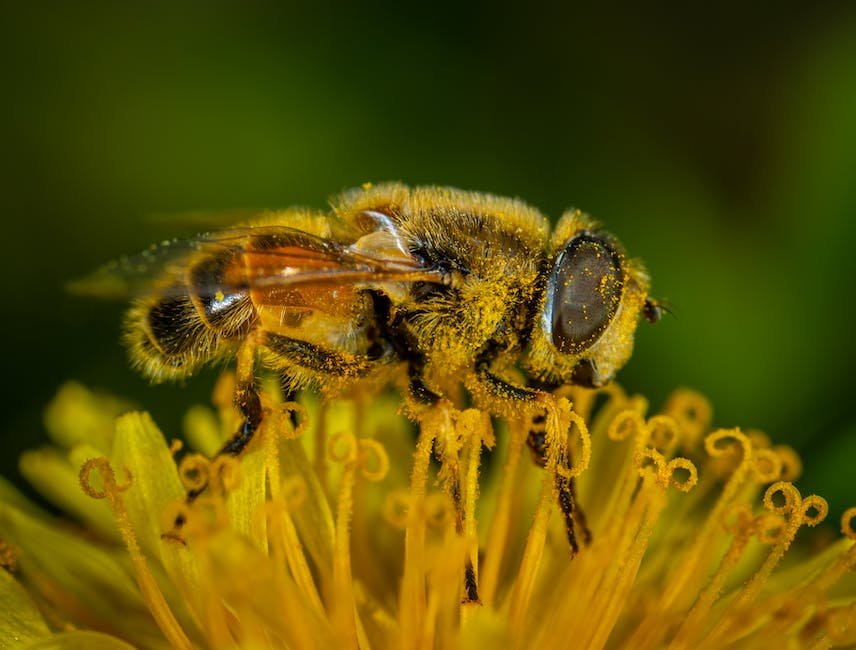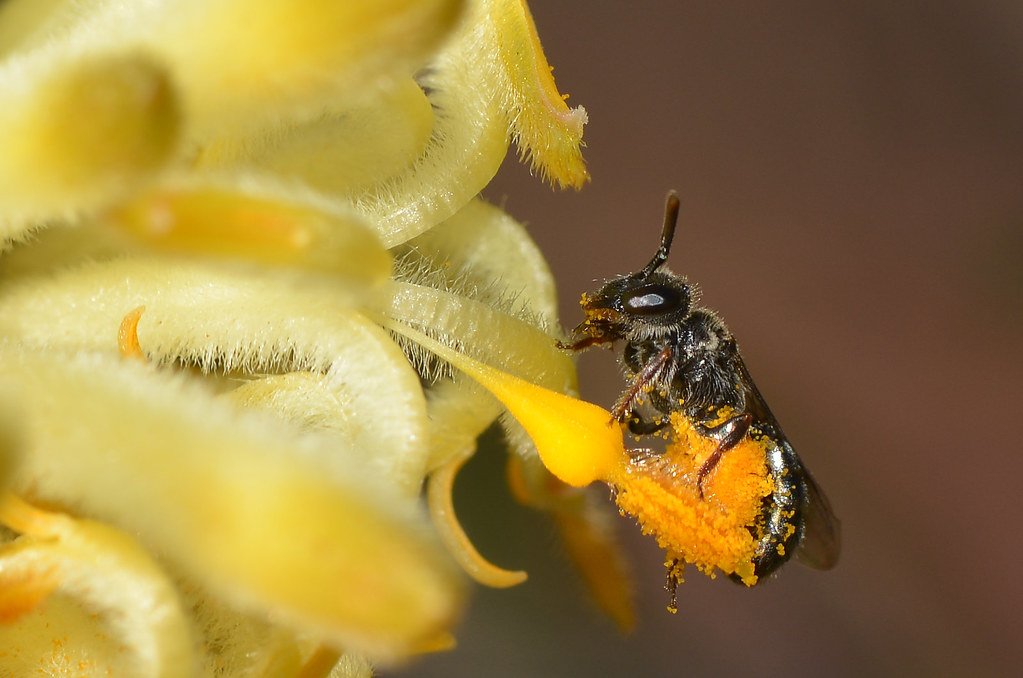Beneath the whispering petals and sun-drenched meadows lies a hidden, intricate relationship that sustains both pollinators and flora alike. Within this delicate dance of nature, pollen emerges as a vital currency of life, an exquisite substance that reveals itself under the microscope as a kaleidoscope of colors and shapes. As the gentle breeze carries these minuscule grains from flower to flower, their pivotal role in bee nutrition is unraveled, showcasing the symbiotic embrace between these buzzing insects and the yellow dust that nourishes their tiny bodies. Join us on a mesmerizing journey into the world of pollen, where we explore the multifaceted dimensions of its contribution to the health and vitality of our beloved bees.
Table of Contents
- The Importance of Pollen in Bee Nutrition
- The Nutritional Composition of Pollen
- The Relationship Between Pollen Availability and Bee Health
- Strategies for Enhancing Pollen Availability in Bee Habitats
- Maximizing Bee Nutrition Through Diversified Pollen Sources
- Q&A
- In Summary

The Importance of Pollen in Bee Nutrition
Pollen, also known as “bee bread,” plays a crucial role in the nutrition and survival of bees. It serves as a primary protein source that sustains their growth, development, and overall health. Here are some key reasons highlighting the significance of pollen in bee nutrition:
- Vital Nutrients: Pollen contains essential amino acids, minerals, vitamins, and fatty acids that bees require for their metabolic processes. These nutrients contribute to their immune system, muscle development, and overall vitality. Without a diverse and balanced pollen diet, bees may become more susceptible to diseases and exhibit reduced reproductive capabilities.
- Colony Growth: For young bees, pollen is the foundation of growth. Nurse bees collect pollen to create “bee bread,” which is then fed to developing larvae. The protein-rich pollen stimulates larval growth and ensures the colony’s continuity. Adequate pollen supplies during the larval stage are vital for the bees’ full development into efficient workers, nurses, drones, and future queens.
- Pollen Diversity: Bees actively seek a variety of pollen sources to maintain optimal nutrition. Different plant species produce unique pollen compositions, offering a range of nutrients. Access to diverse pollen sources ensures a well-rounded diet for bees, preventing nutrient deficiencies and promoting their overall well-being.
- Pollination: While bees benefit from pollen nutritionally, they also contribute to plant reproduction through pollination. As bees collect pollen to store in their specialized pollen baskets, some particles inevitably rub off and transfer from flower to flower. This vital role in pollination supports plant diversity and ecosystem health.
All in all, pollen is a vital component in bee nutrition, ensuring their growth, survival, and ability to maintain ecosystems. By understanding the importance of providing diverse pollen sources, we can support the well-being of these remarkable creatures that contribute so much to our natural world.

The Nutritional Composition of Pollen
Pollen, often associated with its role in plant reproduction, actually possesses a fascinating nutritional composition that is far more than meets the eye. This tiny powerhouse is packed with essential nutrients that contribute to overall health and well-being.
When it comes to macronutrients, pollen emerges as a surprising source of protein, offering all nine essential amino acids needed for bodily functions. Its rich profile includes vitamins, such as vitamin C, vitamin E, and the B-vitamin complex, which play a crucial role in various bodily processes. Additionally, pollen contains an array of minerals like iron, zinc, and magnesium, which are vital for maintaining optimal health.
Beyond these macronutrients, pollen also contains enzymes, antioxidants, and phytonutrients that can support the body’s immune system, aid digestion, and even act as anti-inflammatory agents. The combination of these beneficial compounds makes pollen a potential ally in promoting overall wellness.
Key Nutritional Components Found in Pollen:
- Protein with all nine essential amino acids
- Vitamins like vitamin C, vitamin E, and B-complex vitamins
- Minerals including iron, zinc, and magnesium
- Enzymes for improved digestion
- Antioxidants to combat free radicals
- Phytonutrients with anti-inflammatory properties

The Relationship Between Pollen Availability and Bee Health
Pollen availability plays a crucial role in the overall health and well-being of bees, acting as the main source of essential nutrients they require to thrive. A balanced diet rich in diverse pollen sources directly impacts their immune system, reproduction, and overall resilience against pests and diseases. Let’s explore some fascinating aspects of the intricate relationship that exists between pollen availability and bee health.
Pollen Diversity:
A diverse range of pollen provides bees with a wide array of nutrients, vitamins, and minerals necessary for their growth and development. Just as humans need a varied diet, bees also benefit from a mixture of pollen sources. Different types of pollen have varying nutritional compositions, and an inadequate or monotonous diet can lead to compromised bee immune systems and reduced colony vigor.
Seasonal Challenges:
Throughout the year, pollen availability fluctuates, presenting both opportunities and challenges to bee health. Spring brings a burst of floral abundance, offering numerous pollen sources for bees to collect and store. However, in certain regions or during certain seasons, limited pollen diversity can occur, making it difficult for bees to gather sufficient nutrition. These periods can result in weakened immune systems, reduced brood rearing, and lower colony survival rates.
The Role of Habitat Loss:
Habitat loss and the decreasing availability of flowering plants have become significant challenges for bees. With the expansion of urban areas and intensive agriculture, bee populations often struggle to find adequate and diverse food sources. This scarcity of pollen can have detrimental effects, leading to malnutrition, increased vulnerability to diseases and parasites, and ultimately impacting the sustainability of entire bee populations.
Strategies for Enhancing Pollen Availability in Bee Habitats
Ensuring ample pollen availability in bee habitats is crucial for the well-being of both bees and the larger ecosystem. Here are some innovative strategies that can help enhance pollen resources and sustain bee populations:
- Plant a diverse range of flowering species: To provide a continuous and varied food source for bees, it is important to create habitats with a wide variety of flowering plants. By planting an assortment of flowers that bloom at different times throughout the year, bees can access pollen-rich resources all year round.
- Create pollinator-friendly gardens: Designing gardens specifically to attract bees can greatly enhance their pollen availability. Incorporating native plant species, including those with diverse flower shapes and colors, not only provides valuable nutrition but also entices a broader range of bee species to visit.
- Implement bee-friendly farming practices: In agricultural landscapes, certain practices can boost pollen resources for bees. Planting cover crops, hedgerows, and buffer strips along fields can not only protect bee habitats but also introduce additional sources of pollen. Avoiding or minimizing the use of pesticides is crucial for preserving the health and wellbeing of bees.
By adopting these strategies and promoting an environment rich in diverse and abundant pollen sources, we can contribute to the thriving of bee populations, ensuring their vital role as pollinators and guardians of our ecosystems.
Maximizing Bee Nutrition Through Diversified Pollen Sources
Ensuring the health and vitality of our buzzing friends is of utmost importance for both beekeepers and the ecosystem as a whole. One crucial aspect in achieving this is by . By offering a wide variety of pollen options, we can provide bees with a well-rounded diet that promotes optimal health and longevity.
One method to diversify pollen sources is by cultivating a diverse range of flowering plants. Bees require different types of pollen to fulfill their nutritional needs, and different plant species offer varying levels of essential nutrients. By incorporating flowering plants with distinct colors, shapes, and sizes into our gardens or apiaries, we can ensure that bees have access to a plethora of pollen options. This not only enhances their diet but also supports the overall biodiversity of the area.
Additionally, beekeepers can employ advanced techniques such as pollen traps to collect pollen from specific plant species. This allows them to offer bees a concentrated and targeted source of pollen that may be limited or not naturally available in the surrounding environment. By strategically placing these traps and rotating them between different plant species, beekeepers can provide supplemental nutrition that complements the natural foraging habits of the bees.
- Diversifying pollen sources:
- Cultivating a variety of flowering plants
- Providing distinct colors, shapes, and sizes of flowers
- Supporting biodiversity
- Advanced techniques:
- Using pollen traps
- Collecting pollen from specific plant species
- Offering targeted supplementation
In conclusion, is key to promoting the well-being of these incredible pollinators. By creating an environment rich in diverse flowering plants and employing advanced techniques like pollen traps, we can provide bees with a balanced and nutritious diet. Let us join hands in ensuring the thriving health of our vital bee populations.
Q&A
What is the main role of pollen in bee nutrition?
Pollen is a vital protein source for bees, providing them with amino acids necessary for growth, development, and maintenance of their bodies.
How do bees collect and transport pollen?
Bees use their specialized body structures to collect pollen from flowers. They pack the pollen into tiny baskets on their hind legs called pollen baskets or corbiculae. They then transport it back to their hive.
What nutritional components are found in pollen?
Pollen contains a wide array of essential nutrients for bees, including proteins, carbohydrates, lipids, vitamins, minerals, and enzymes. These nutrients help sustain the bee’s metabolic functions and enhance their overall health.
How is pollen transformed into bee food?
Bees mix collected pollen with nectar in their honey stomachs, forming a sticky mass known as “bee bread.” They then store this bee bread in honeycomb cells, where it undergoes enzymatic fermentation, breaking down the complex components into simpler forms accessible to the bees.
Why do bees need such high protein diets?
Bees require substantial amounts of protein to support their rapid growth during the larval stage and to maintain their strength and well-being throughout their lives. Protein is crucial for various physiological processes, including tissue repair and the production of enzymes and hormones.
Do all bees feed on pollen?
While most adult bees rely on a mixture of nectar and pollen as their primary food source, certain bee species, like honey bees, depend more heavily on pollen due to their complex social structure and the nutritional needs of their developing larvae.
What would happen if bees were deprived of pollen?
Pollen deprivation can have severe consequences for bee colonies, leading to nutritional deficiencies, decreased immunity, and impaired reproduction. It can ultimately weaken the population, making them more vulnerable to diseases and environmental stressors.
Can bees acquire all necessary nutrients from a single type of pollen?
While bees can thrive on a diverse pollen diet, it is generally beneficial for them to have access to a variety of pollen types. Diverse sources provide different nutrients, vitamins, and minerals, promoting a more balanced and complete nutritional profile for the bees.
How does pollen collection contribute to biodiversity?
When bees collect pollen from different plant species, they inadvertently facilitate cross-pollination. This process enhances genetic diversity within plant populations, promotes plant reproduction, and contributes to the overall biodiversity of ecosystems.
What are the environmental impacts of pollen foraging?
Pollen collection by bees has a positive environmental impact as it supports the pollination of flowering plants, ensuring the production of fruits, seeds, and new plants. This process plays a crucial role in maintaining ecosystem stability and enhancing biodiversity.
In Summary
As we bid adieu to this exploration into the role of pollen in bee nutrition, we find ourselves marveling at the intricate dance of nature. From the minuscule grains of pollen to the tireless buzz of the bees, a symphony of life unfolds before our very eyes. In our quest to understand the essential nourishment that sustains these remarkable creatures, we have delved deep into their vibrant world.
Pollen, often overlooked by many, reveals its true significance as a veritable treasure trove of nutrients that keeps the hive thriving. In this intricate natural tapestry, bees embark on a delicate journey, flitting from blossom to blossom, gracefully collecting these golden nuggets of sustenance. And with each precious grain they gather, they weave the very fabric of their existence.
Through the pollen’s abundant proteins, essential amino acids, vitamins, and minerals, the bees fortify their own health and well-being. It is within this ephemeral, powdery realm that the harmony of nature emerges, acting as a life force essential for the pollinators’ strength and vitality. As they diligently navigate their foraging expeditions, these industrious insects gift the world an extraordinary gift: the pollination that underpins the rich tapestry of life on Earth.
But let us not forget the intricacies that exist within this fascinating mutualism between bees and pollen. As the bees diligently seek nourishment, they inadvertently facilitate the reproduction of flowering plants, perpetuating the cycle of life. A magnificent symbiosis unfolds – as bees feast on pollen, they unwittingly foster the fertility of myriad plant species, contributing to the splendor of our diverse ecosystems.
As we close this chapter on the role of pollen in bee nutrition, let us carry forward a newfound appreciation for the delicate interconnections that nourish life. Let us cherish the tireless endeavors of these remarkable creatures and the ethereal contributions that pollen bestows upon them. In this symbiotic dance, we are reminded of the infinite wonder and complexity that nature so graciously bestows upon us.
And so, as we bid farewell to the enchanting world of pollen and bees, let us venture forth with open eyes and hearts, ever mindful of the profound significance that even the tiniest grain can hold. For it is within the delicate embrace of nature’s offerings that life blossoms, creating harmony and splendor for all to behold.
As an affiliate, my content may feature links to products I personally use and recommend. By taking action, like subscribing or making a purchase, you’ll be supporting my work and fueling my taco cravings at the same time. Win-win, right?
Want to read more? Check out our Affiliate Disclosure page.


